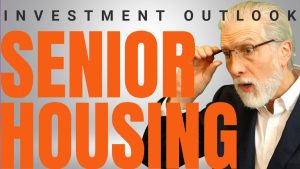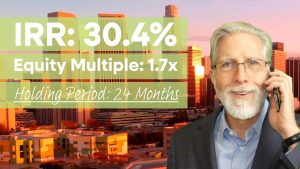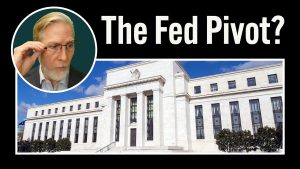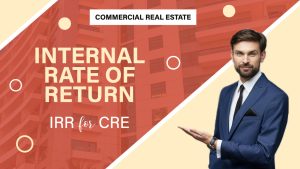Takeaways
- A convergence of market forces has so far resulted in a lack of CRE transactions.
- The need for banks to shore up their balance sheets will stop the practice of extend and pretend.
- Both banks and sellers will soon have to acquiesce to lower market values, a market reset.
The current commercial real estate downturn has so far been marked by a frustrating lack of transactions. There are lots of willing buyers out there – count me as one of them – but they’re looking for significant discounts from recent pricing peaks. On the other side of the equation, sellers are generally reluctant to sell given current market conditions, many of them still clinging to pricing that precedes the Federal Reserve’s rate hikes of 2022 and 2023. Here’s some good news, that’s about to change. In this video, I’ll explain how we’re entering an ideal time to invest in commercial real estate.
Market Values are Down
Even though the process of price discovery is significantly impeded in a market with few transactions, there’s little doubt that market values are down. Let’s consider data from Green Street. As per their Commercial Property Price Index, or CPPI, the most recent peak was in March 2022. Not coincidentally, that’s also when the Fed started raising rates. Between that time and July 2023, the fed funds target range was raised a total of 11 times, going from 0%-0.25% to 5.25%-5.50%, which is where it remains today. The impact of these rate hikes on commercial real estate has been tremendous.
Once again referencing data from Green Street, the CPPI is currently down 21% from its peak. That’s across the board, what they call their all-property index. At their sector-level indexes, some property types are doing better than others, but everything is down. For example, apartment is down 26%, industrial is down 17%, and strip retail is down 16%. Not surprisingly, office has seen the greatest decline, down 37%. Of course, the market value of any individual property may or may not correlate with an index. In the aggregate, however, it’s a meaningful indication of how the market has changed over the past 30 or so months.
Term (Usually) Drives Transactions
If the commercial real estate market was perfectly efficient, if market participants were following the rules, a great many owners of investment properties would currently be facing some difficult decisions. More importantly, for this audience of investors, prospective buyers would currently be finding a lot more opportunities to acquire properties at favorable prices. Let me explain.
Loans for commercial real estate seldom have terms longer than 10 years, and many of them have terms of less than five years. To be clear, term differs from amortization. The loan amount is typically amortized over 25 or 30 years. If the corresponding term was also 25 or 30 years, respectively, the hypothetical loan in question would eventually be repaid in its entirety by means of monthly payments. In other words, it would be a fully amortizing loan. When people finance the purchase of their homes in the United States, it’s more often than not done by means of a fully amortizing loan. But, that’s not the way it works in the commercial real estate industry.
In almost every situation, loans for commercial real estate have terms that are much shorter than amortization. As such, when the loan comes to term at the end of 3, 5, 7, or 10 years, the borrower is still going to be a long way from paying it off. Under normal circumstances, when market conditions are more favorable, a borrower in this situation has two options: 1) they can refinance the property, paying off the old loan with proceeds from the new loan; or 2) they can sell the property, paying off the loan with proceeds from the sale.
Banks Unenthusiastic to Refinance
The current market, however, is far from normal. A plurality of banks, in particular, regional banks, which were originating over a third of all commercial real estate loans in the runup to the downturn, have largely retreated from the market. As for the banks that remain, those still willing to consider financing for commercial real estate, they’ve generally become much more conservative in their underwriting standards. Maximum loan-to-value has come down and minimum debt-service coverage has gone up. When you combine that with current interest rates, the once reliable rate-and-term refi is not likely to even be an option for a lot of borrowers. Instead, they would have to bring in equity to pay down the debt, effectively resizing the loan to a level that meets current underwriting criteria.
Borrowers Unenthusiastic to Sell
The current market, however, is far from normal. A plurality of banks, in particular, regional banks, which were originating over a third of all commercial real estate loans in the runup to the downturn, have largely retreated from the market. As for the banks that remain, those still willing to consider financing for commercial real estate, they’ve generally become much more conservative in their underwriting standards. Maximum loan-to-value has come down and minimum debt-service coverage has gone up. When you combine that with current interest rates, the once reliable rate-and-term refi is not likely to even be an option for a lot of borrowers. Instead, they would have to bring in equity to pay down the debt, effectively resizing the loan to a level that meets current underwriting criteria.
Extend and Pretend
So, if borrowers are unable to pay off their loans at maturity, why aren’t the banks foreclosing? After all, there is, in fact, a third option available to borrowers when times are tough. They can always give the keys back to the bank. Some high-profile examples of this have actually made the news over the past 12 to 18 months. For the most part, however, banks have been choosing to extend and pretend, biding time in hopes of interest rate cuts by the Federal Reserve. Here’s the thing, it’s a lot easier to get away with extending and pretending when everyone believes rate cuts are eminent.
As I’m sure all of you remember, it wasn’t that long ago that pundits were forecasting six or more cuts in 2024. In retrospect, that was little more than wishful thinking. The market had gotten so used to artificially low interest rates – an age of easy money – that a return to normalcy failed to even compute with a lot of market participants. It’s as if they had forgotten how to even function without favorable policy decisions by the Fed driving the success of their investments.
As time has continued to go by, without any cuts taking place, the stark reality of present circumstances is finally starting to sink in. Contrary to the descriptor that’s often bandied about when speaking of higher-for-longer interest rates, this is not the new normal. Instead, it’s a market reset, a return to the real normal, and acceptance of this is about to dramatically accelerate. In a recent report by Newmark, they estimated that $2 trillion in commercial real estate debt will be maturing by 2026, with almost half of it coming due before the end of this year, in no small part because of extend and pretend.
Now’s the Time to Invest!
This incoming tidal wave of maturities is going to put tremendous regulatory pressure on banks to shore up their balance sheets. That pressure, combined with the inescapable end of artificially low interest rates, is finally going to force their hand, unleashing transactional activity as properties are pushed to market in efforts to deal with maturing loans. The increase in transactions will drive price discovery, with both sellers and banks ultimately acquiescing to lower sale prices. For well capitalized equity investors that can quickly respond to the market reset, the next few years will offer up countless opportunities to acquire commercial real estate at favorable entry points. It’s going to be an ideal time to invest in commercial real estate.




















